2001 NISSAN PICK-UP check oil
[x] Cancel search: check oilPage 889 of 1306
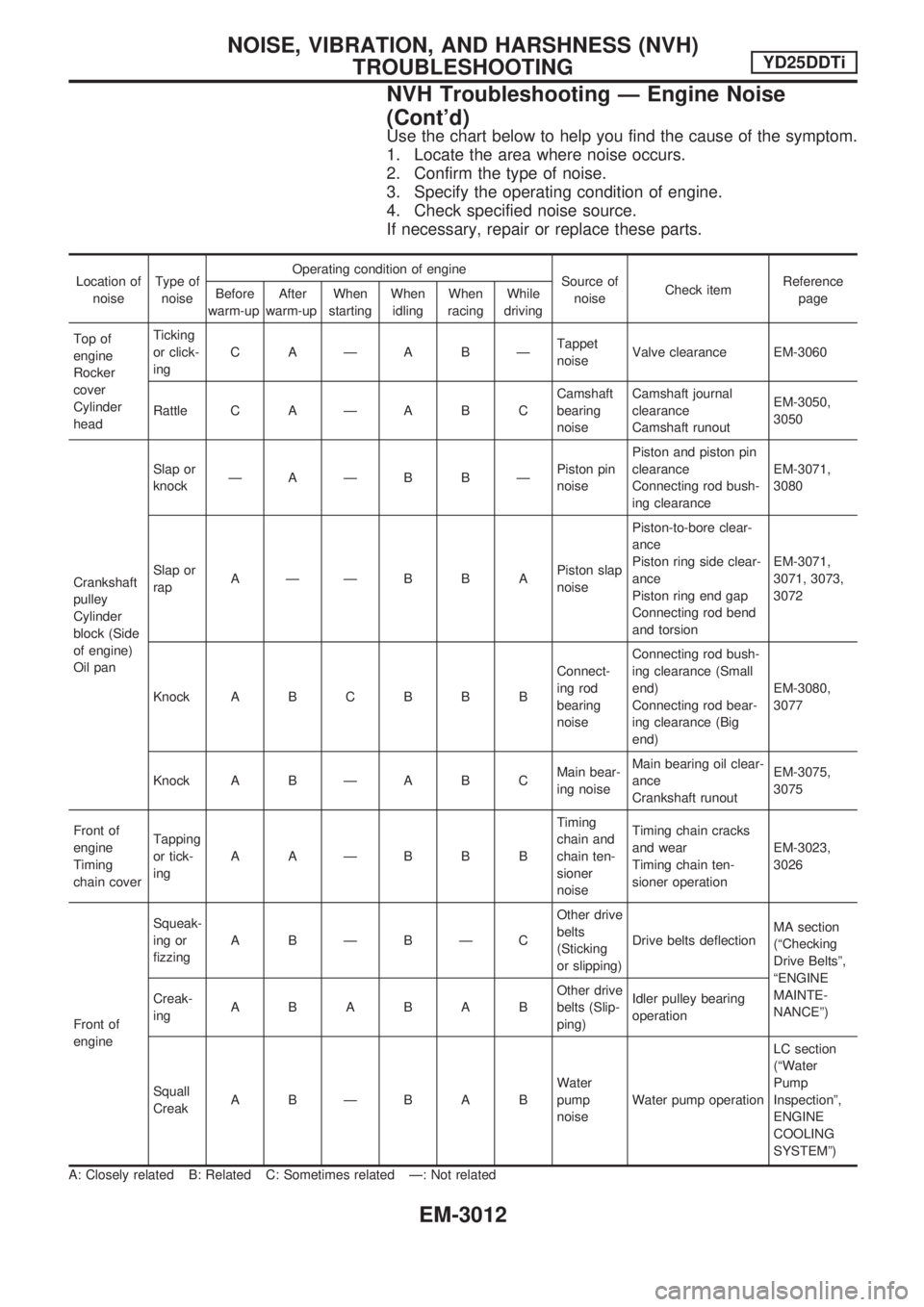
Use the chart below to help you find the cause of the symptom.
1. Locate the area where noise occurs.
2. Confirm the type of noise.
3. Specify the operating condition of engine.
4. Check specified noise source.
If necessary, repair or replace these parts.
Location of
noiseType of
noiseOperating condition of engine
Source of
noiseCheck itemReference
page Before
warm-upAfter
warm-upWhen
startingWhen
idlingWhen
racingWhile
driving
Top of
engine
Rocker
cover
Cylinder
headTicking
or click-
ingCAÐABÐTappet
noiseValve clearance EM-3060
Rattle C A Ð A B CCamshaft
bearing
noiseCamshaft journal
clearance
Camshaft runoutEM-3050,
3050
Crankshaft
pulley
Cylinder
block (Side
of engine)
Oil panSlap or
knockÐAÐB BÐPiston pin
noisePiston and piston pin
clearance
Connecting rod bush-
ing clearanceEM-3071,
3080
Slap or
rapAÐÐBBAPiston slap
noisePiston-to-bore clear-
ance
Piston ring side clear-
ance
Piston ring end gap
Connecting rod bend
and torsionEM-3071,
3071, 3073,
3072
Knock A B C B B BConnect-
ing rod
bearing
noiseConnecting rod bush-
ing clearance (Small
end)
Connecting rod bear-
ing clearance (Big
end)EM-3080,
3077
Knock A B Ð A B CMain bear-
ing noiseMain bearing oil clear-
ance
Crankshaft runoutEM-3075,
3075
Front of
engine
Timing
chain coverTapping
or tick-
ingAAÐBBBTiming
chain and
chain ten-
sioner
noiseTiming chain cracks
and wear
Timing chain ten-
sioner operationEM-3023,
3026
Front of
engineSqueak-
ing or
fizzingABÐBÐCOther drive
belts
(Sticking
or slipping)Drive belts deflectionMA section
(ªChecking
Drive Beltsº,
ªENGINE
MAINTE-
NANCEº) Creak-
ingABABABOther drive
belts (Slip-
ping)Idler pulley bearing
operation
Squall
CreakABÐBABWater
pump
noiseWater pump operationLC section
(ªWater
Pump
Inspectionº,
ENGINE
COOLING
SYSTEMº)
A: Closely related B: Related C: Sometimes related Ð: Not related
NOISE, VIBRATION, AND HARSHNESS (NVH)
TROUBLESHOOTINGYD25DDTi
NVH Troubleshooting Ð Engine Noise
(Cont'd)
EM-3012
Page 901 of 1306
![NISSAN PICK-UP 2001 Repair Manual 3. Using a hexagon-head wrench [face to face: 6 mm (0.24 in),
SST], install timing chain slack guide.
4. Install chain tensioner.
a. Push the plunger of the chain tensioner. While holding it with
a pu NISSAN PICK-UP 2001 Repair Manual 3. Using a hexagon-head wrench [face to face: 6 mm (0.24 in),
SST], install timing chain slack guide.
4. Install chain tensioner.
a. Push the plunger of the chain tensioner. While holding it with
a pu](/manual-img/5/57372/w960_57372-900.png)
3. Using a hexagon-head wrench [face to face: 6 mm (0.24 in),
SST], install timing chain slack guide.
4. Install chain tensioner.
a. Push the plunger of the chain tensioner. While holding it with
a push pin, install the chain tensioner.
b. Using a hexagon-head wrench [face to face: 5 mm (0.20 in),
SST], tighten bolts.
c. Pull out the push pin, etc. holding the plunger.
+Check again that the alignment marks on the sprockets
and the colored alignment marks on the timing chain are
aligned.
5. Install front chain case.
a. Install tension guide on the back surface of front chain case.
+Hold front chain case vertically when installing. Tension
guide may come off if front chain case is tilted.
b. Apply specified liquid gasket (Refer to EM-3003, ªLiquid Gas-
ket
Application Procedureº.) on both ends of arched area (loca-
tions where rear chain case is adjoined) as shown in the fig-
ure.
c. Install new chain case gasket to chain case groove.
d. Install front chain case.
+When installing, align dowel pin on oil pump case with the pin
hole.
+Install all bolts with the rubber washer to the front chain case.
e. Tighten fixing bolts in the numerical order shown in the fig-
ure.
f. After tightening all the bolts, re-tighten in the No. 1, 2, and 6
bolts.
SBIA0228E
SBIA0227E
SBIA0189E
JEM129G
JEM121G
TIMING CHAINYD25DDTi
Secondary Timing Chain (Cont'd)
EM-3024
Page 909 of 1306
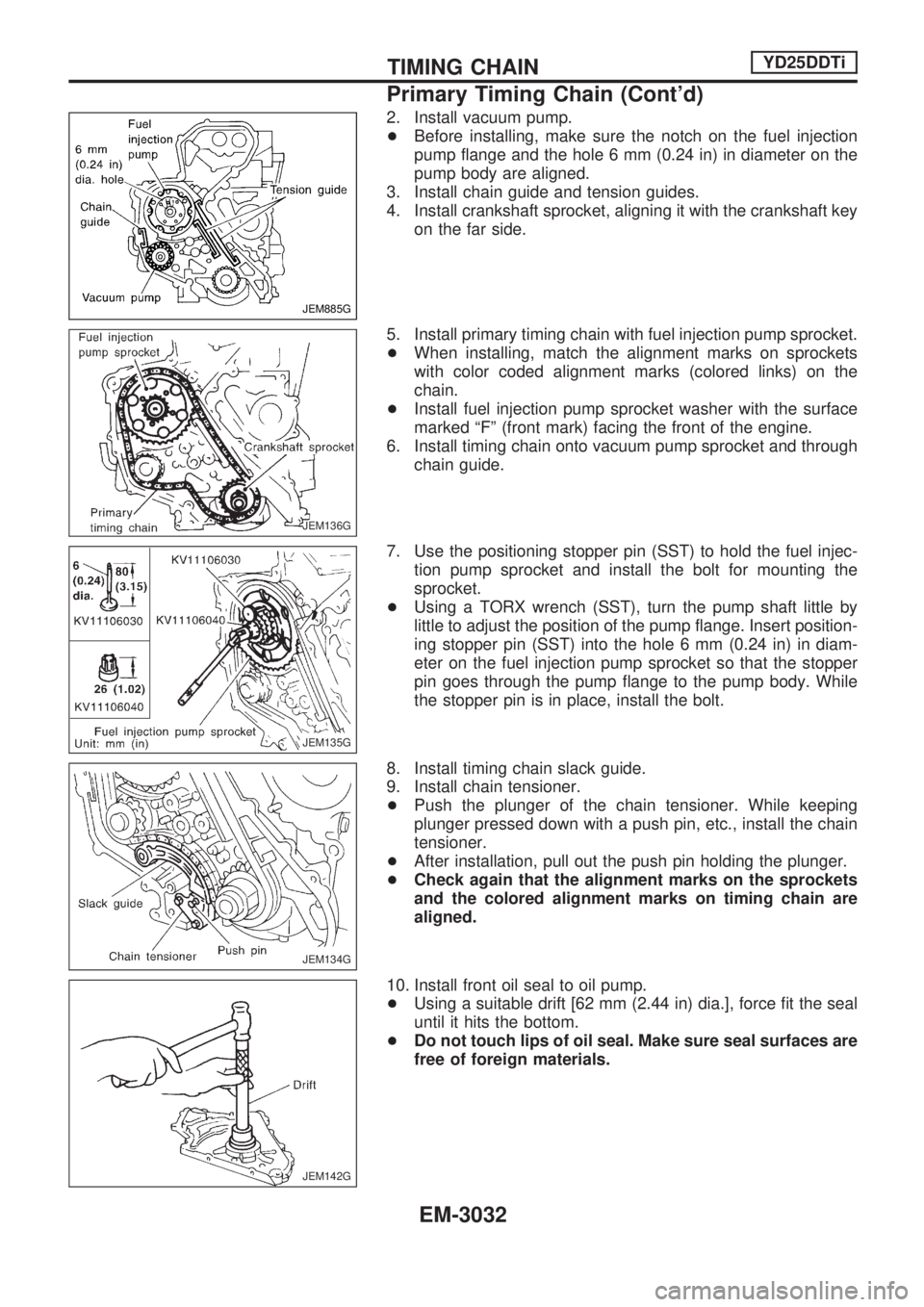
2. Install vacuum pump.
+Before installing, make sure the notch on the fuel injection
pump flange and the hole 6 mm (0.24 in) in diameter on the
pump body are aligned.
3. Install chain guide and tension guides.
4. Install crankshaft sprocket, aligning it with the crankshaft key
on the far side.
5. Install primary timing chain with fuel injection pump sprocket.
+When installing, match the alignment marks on sprockets
with color coded alignment marks (colored links) on the
chain.
+Install fuel injection pump sprocket washer with the surface
marked ªFº (front mark) facing the front of the engine.
6. Install timing chain onto vacuum pump sprocket and through
chain guide.
7. Use the positioning stopper pin (SST) to hold the fuel injec-
tion pump sprocket and install the bolt for mounting the
sprocket.
+Using a TORX wrench (SST), turn the pump shaft little by
little to adjust the position of the pump flange. Insert position-
ing stopper pin (SST) into the hole 6 mm (0.24 in) in diam-
eter on the fuel injection pump sprocket so that the stopper
pin goes through the pump flange to the pump body. While
the stopper pin is in place, install the bolt.
8. Install timing chain slack guide.
9. Install chain tensioner.
+Push the plunger of the chain tensioner. While keeping
plunger pressed down with a push pin, etc., install the chain
tensioner.
+After installation, pull out the push pin holding the plunger.
+Check again that the alignment marks on the sprockets
and the colored alignment marks on timing chain are
aligned.
10. Install front oil seal to oil pump.
+Using a suitable drift [62 mm (2.44 in) dia.], force fit the seal
until it hits the bottom.
+Do not touch lips of oil seal. Make sure seal surfaces are
free of foreign materials.
JEM885G
JEM136G
JEM135G
JEM134G
JEM142G
TIMING CHAINYD25DDTi
Primary Timing Chain (Cont'd)
EM-3032
Page 910 of 1306
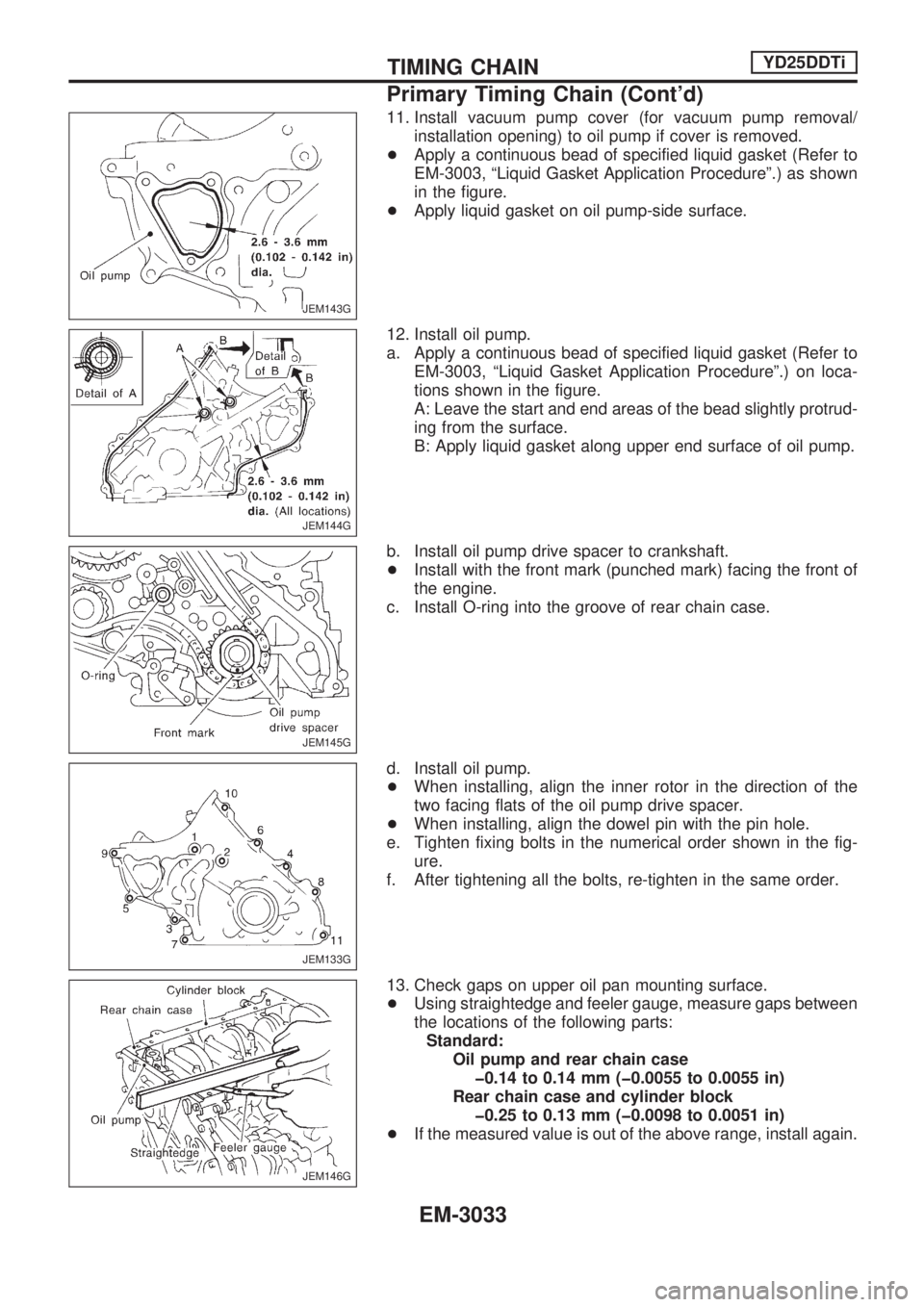
11. Install vacuum pump cover (for vacuum pump removal/
installation opening) to oil pump if cover is removed.
+Apply a continuous bead of specified liquid gasket (Refer to
EM-3003, ªLiquid Gasket Application Procedureº.) as shown
in the figure.
+Apply liquid gasket on oil pump-side surface.
12. Install oil pump.
a. Apply a continuous bead of specified liquid gasket (Refer to
EM-3003, ªLiquid Gasket Application Procedureº.) on loca-
tions shown in the figure.
A: Leave the start and end areas of the bead slightly protrud-
ing from the surface.
B: Apply liquid gasket along upper end surface of oil pump.
b. Install oil pump drive spacer to crankshaft.
+Install with the front mark (punched mark) facing the front of
the engine.
c. Install O-ring into the groove of rear chain case.
d. Install oil pump.
+When installing, align the inner rotor in the direction of the
two facing flats of the oil pump drive spacer.
+When installing, align the dowel pin with the pin hole.
e. Tighten fixing bolts in the numerical order shown in the fig-
ure.
f. After tightening all the bolts, re-tighten in the same order.
13. Check gaps on upper oil pan mounting surface.
+Using straightedge and feeler gauge, measure gaps between
the locations of the following parts:
Standard:
Oil pump and rear chain case
þ0.14 to 0.14 mm (þ0.0055 to 0.0055 in)
Rear chain case and cylinder block
þ0.25 to 0.13 mm (þ0.0098 to 0.0051 in)
+If the measured value is out of the above range, install again.
JEM143G
JEM144G
JEM145G
JEM133G
JEM146G
TIMING CHAINYD25DDTi
Primary Timing Chain (Cont'd)
EM-3033
Page 918 of 1306
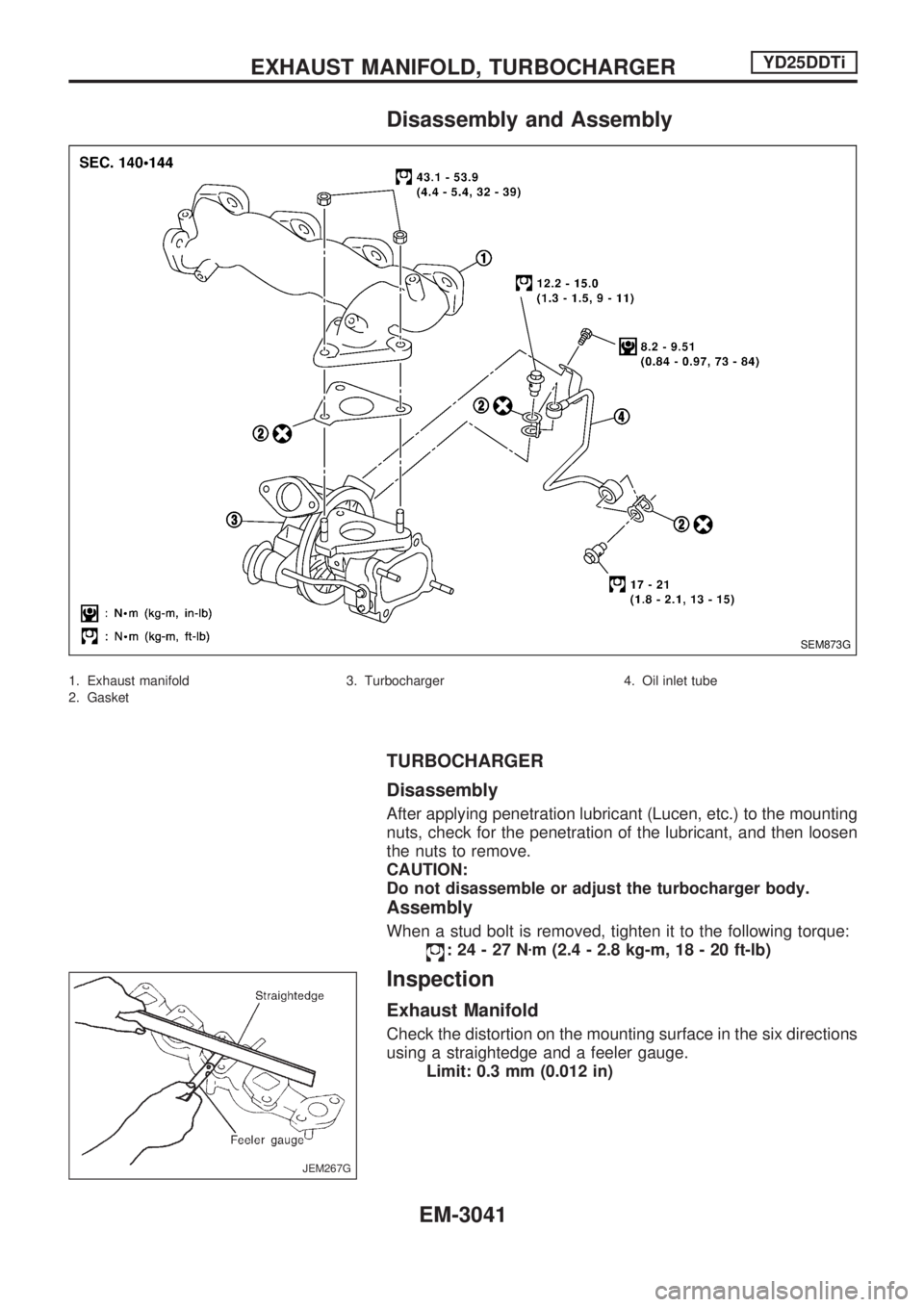
Disassembly and Assembly
1. Exhaust manifold
2. Gasket3. Turbocharger 4. Oil inlet tube
TURBOCHARGER
Disassembly
After applying penetration lubricant (Lucen, etc.) to the mounting
nuts, check for the penetration of the lubricant, and then loosen
the nuts to remove.
CAUTION:
Do not disassemble or adjust the turbocharger body.
Assembly
When a stud bolt is removed, tighten it to the following torque:
:24-27Nzm (2.4 - 2.8 kg-m, 18 - 20 ft-lb)
Inspection
Exhaust Manifold
Check the distortion on the mounting surface in the six directions
using a straightedge and a feeler gauge.
Limit: 0.3 mm (0.012 in)
SEM873G
JEM267G
EXHAUST MANIFOLD, TURBOCHARGERYD25DDTi
EM-3041
Page 920 of 1306

Turbine Wheel
+Check that there is no oil adhesion.
+Check that there is no carbon accumulation.
+Check that blades of the turbine wheel are not bent or bro-
ken.
+Check that the turbine wheel does not interfere with the tur-
bine housing.
Compressor Wheel
+Check that there is no oil adhesion inside the air inlet.
+Check that the compressor wheel does not interfere with the
compressor housing.
+Check that the wheel is not bent or broken.
Wastegate Valve Actuator
+Connect the handy pump to the actuator, and check that the
rod strokes smoothly in compliance with the following pres-
sure.
+Pressure to be applied at actuator part to move rod end as
follows:
Standard (Pressure/rod stroke amount):
143.7 - 152.9 kPa (1,437 - 1,529 mbar, 1,077.8 -
1,146.8 mmHg, 42.4 - 45.1 inHg)/2.0 mm (0.0787 in)
161.4 - 174.8 kPa (1,614 - 1,748 mbar, 1,210.5 -
1,311.0 mmHg, 47.7 - 51.6 inHg)/4.0 mm (0.157 in)
SEM877G
SEM878G
SEM879G
EXHAUST MANIFOLD, TURBOCHARGERYD25DDTi
Inspection (Cont'd)
EM-3043
Page 921 of 1306
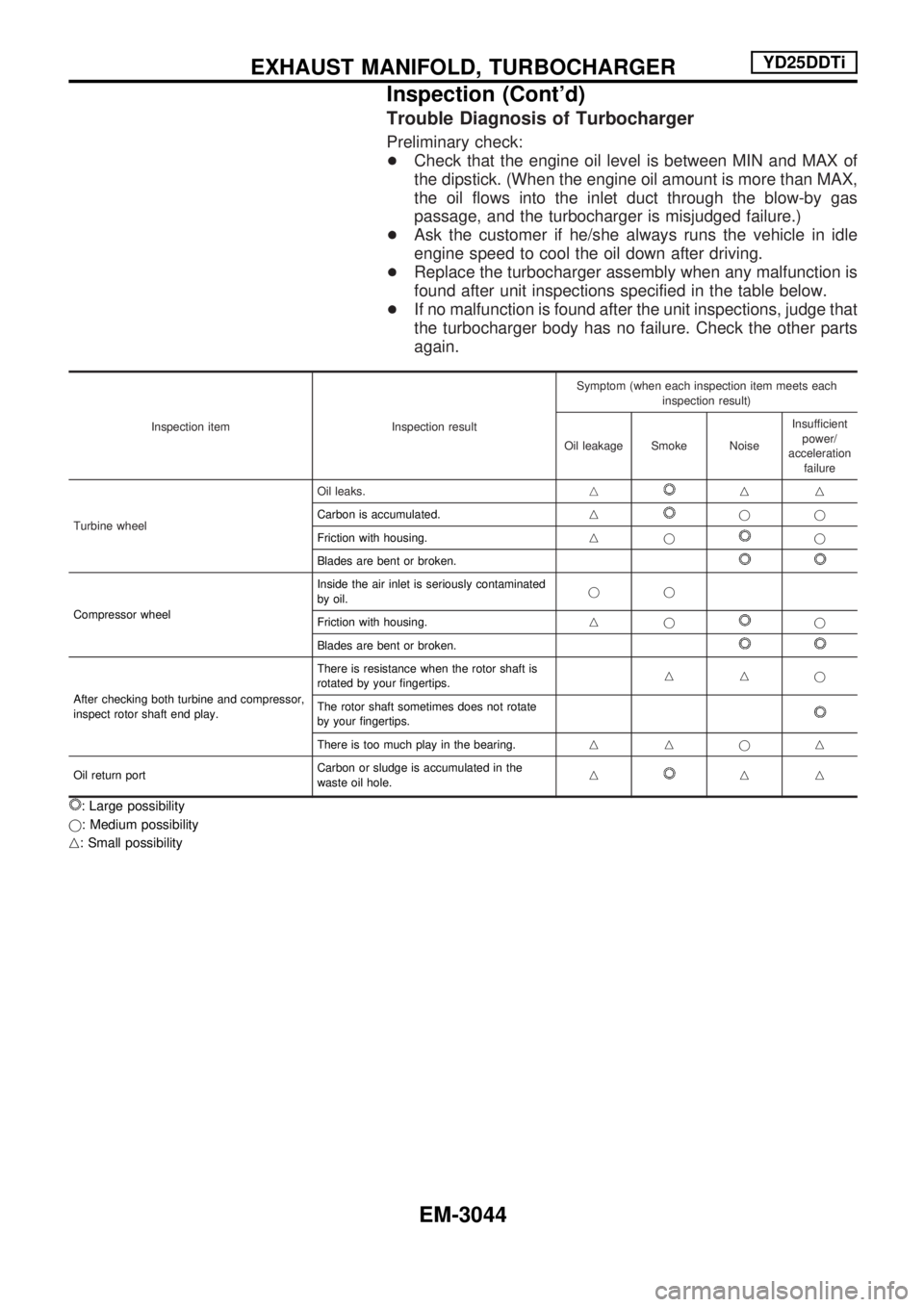
Trouble Diagnosis of Turbocharger
Preliminary check:
+Check that the engine oil level is between MIN and MAX of
the dipstick. (When the engine oil amount is more than MAX,
the oil flows into the inlet duct through the blow-by gas
passage, and the turbocharger is misjudged failure.)
+Ask the customer if he/she always runs the vehicle in idle
engine speed to cool the oil down after driving.
+Replace the turbocharger assembly when any malfunction is
found after unit inspections specified in the table below.
+If no malfunction is found after the unit inspections, judge that
the turbocharger body has no failure. Check the other parts
again.
Inspection item Inspection resultSymptom (when each inspection item meets each
inspection result)
Oil leakage Smoke NoiseInsufficient
power/
acceleration
failure
Turbine wheelOil leaks.n
nn
Carbon is accumulated.n
jj
Friction with housing.nj
j
Blades are bent or broken.
Compressor wheelInside the air inlet is seriously contaminated
by oil.jj
Friction with housing.njj
Blades are bent or broken.
After checking both turbine and compressor,
inspect rotor shaft end play.There is resistance when the rotor shaft is
rotated by your fingertips.nnj
The rotor shaft sometimes does not rotate
by your fingertips.
There is too much play in the bearing.nnjn
Oil return portCarbon or sludge is accumulated in the
waste oil hole.n
nn
: Large possibility
j: Medium possibility
n: Small possibility
EXHAUST MANIFOLD, TURBOCHARGERYD25DDTi
Inspection (Cont'd)
EM-3044
Page 926 of 1306
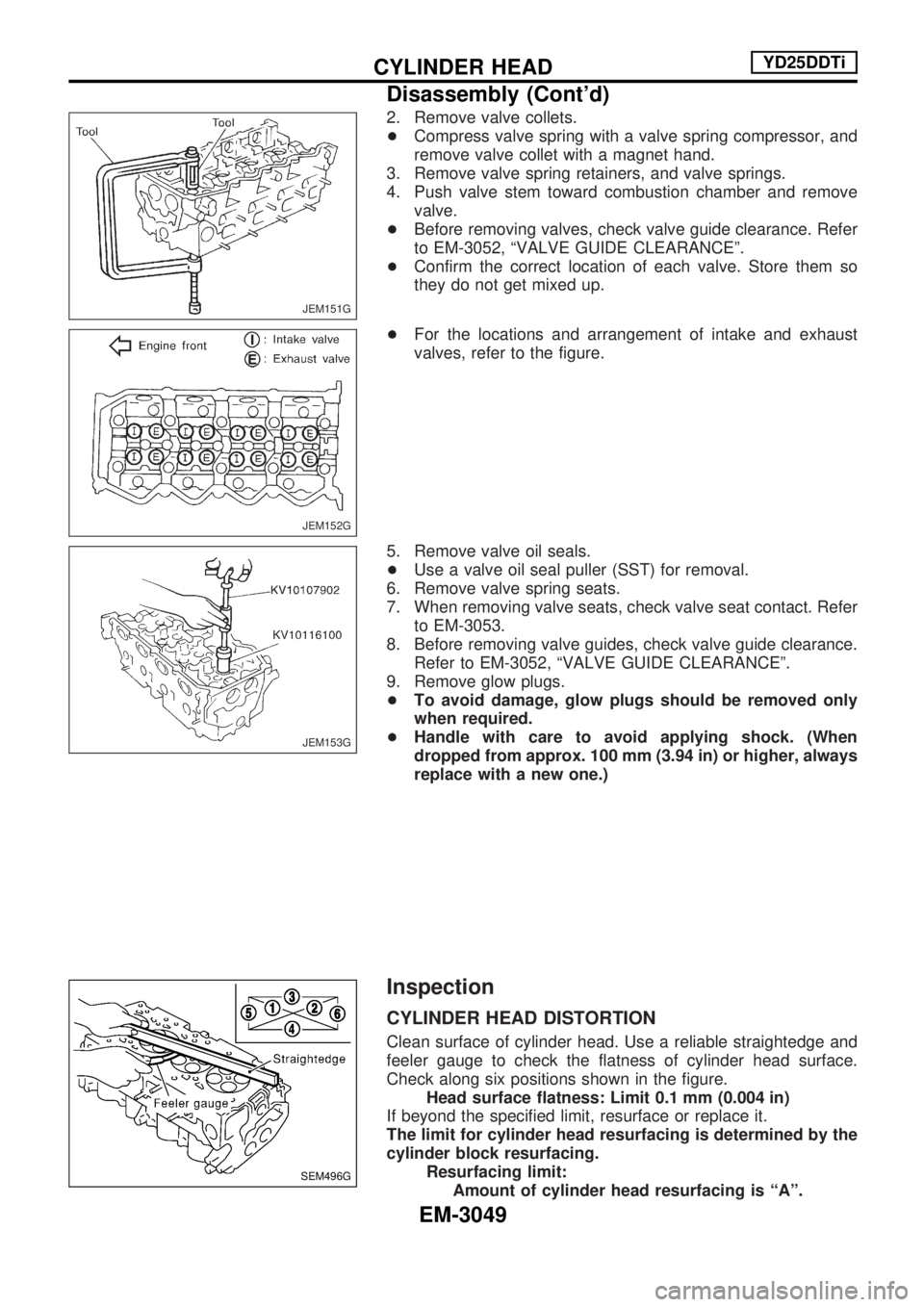
2. Remove valve collets.
+Compress valve spring with a valve spring compressor, and
remove valve collet with a magnet hand.
3. Remove valve spring retainers, and valve springs.
4. Push valve stem toward combustion chamber and remove valve.
+ Before removing valves, check valve guide clearance. Refer
to EM-3052, ªVALVE GUIDE CLEARANCEº.
+ Confirm the correct location of each valve. Store them so
they do not get mixed up.
+ For the locations and arrangement of intake and exhaust
valves, refer to the figure.
5. Remove valve oil seals.
+ Use a valve oil seal puller (SST) for removal.
6. Remove valve spring seats.
7. When removing valve seats, check valve seat contact. Refer to EM-3053.
8. Before removing valve guides, check valve guide clearance. Refer to EM-3052, ªVALVE GUIDE CLEARANCEº.
9. Remove glow plugs.
+ To avoid damage, glow plugs should be removed only
when required.
+ Handle with care to avoid applying shock. (When
dropped from approx. 100 mm (3.94 in) or higher, always
replace with a new one.)
Inspection
CYLINDER HEAD DISTORTION
Clean surface of cylinder head. Use a reliable straightedge and
feeler gauge to check the flatness of cylinder head surface.
Check along six positions shown in the figure.
Headsurfaceflatness:Limit0.1 mm(0.004 in)
If beyond the specified limit, resurface or replace it.
The limit for cylinder head resurfacing is determined by the
cylinder block resurfacing. Resurfacing limit:Amount of cylinder head resurfacing is ªAº.
JEM151G
JEM152G
JEM153G
SEM496G
CYLINDER HEADYD25DDTi
Disassembly (Cont'd)
EM-3049